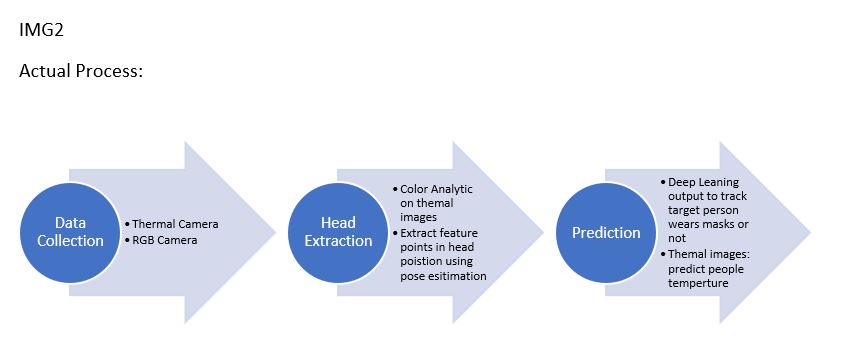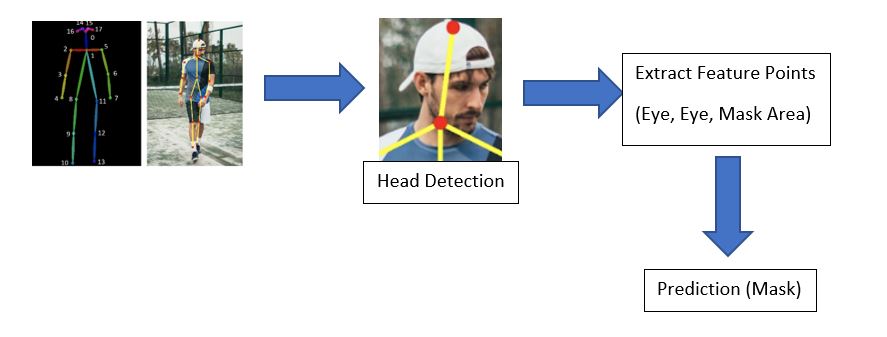| I&T Solution |
Mask Detection and Thermal Temperature Measurement in Pedestrians using Computer Vision
(REF : S-0309)
|
| Trial Project |
|
| Solution Feature |
- Our solution makes use of two cameras: thermal and standard camera. Thermal Camera: to detect the target person’s temperature. Standard camera: mask detection. Fusion of the two image sources with use of deep learning models on the two sources would help improve the overall performance.
- A combination of deep learning and computer vision algorithms is employed in face detection, mask object detection and positive/negative classification. “Stepwise” and “ensemble” model methodology will be identified to provide both fast and accurate detection via transferred learning and cross validation.
- The persons who are potentially with fever or without mask will be highlighted in the video, and visual and audible alarm will be raised. The alarm list, associated with the scenes of alarms will be archived for further check. Visualization and Statistics on alarms will be provided.
- Standard 1920x1080 camera and thermal camera with accuracy <=0.3C can be used in the solution as the dual video source. GPU is needed in this solution. The solution will be network based. The whole architecture can either be on the cloud or on-premises, depending on client’s preference.
- Technologies we use: data analytics on thermal camera data, e.g. heat map color analysis; Standard camera pose estimation for people detection, recognizing target object is human, then post analysis head and mask position. Moreover, motion detection data and heat map color data in thermal camera would be used for referencing.



|
| Trial Application and Expected Outcome |
- Temperature: Able to configure the temperature so that we can easily test fever cases and normal cases; Footage of different persons wearing masks will be used in the data collection and data testing phases. Temperature detection benchmarking and calibration will be conducted, both in lab and on-site.
- Two typical use cases will be considered: people queue in line and identification is one at a time at the gate, higher accuracy is expected; people walking in random in a large concourse, the detection is in parallel for all the identifiable persons with fever or without mask.
- Primary objectives: Identify people with fever; Identify people wearing no masks; Video output with above identified alarms objects highlighted; Dashboard of real-time alarms and statistics. Secondary objectives: The severity of fever; Type of masks; Are masks worn correctly; Dashboard of historical statistics
- Performance: In-lab training and models buildup will be conducted to achieve good accuracy on facial feature temperature identification. High-accuracy on use-case of people in queue will be achieved; On-site further training and calibration will be conducted for use case of people walking in random in concourse.
- Performance: Significant workload must be invested in the trials for improving the performance. Simple accuracy measurement is not enough. While both high precision (i.e. low false alarms) and high recall (i.e. low false negatives) are important, trade-off between the two must be made.
|
| Info on I&T Solution Provider |
| Solution Provider | : | Siemens Ltd |
| Address | : | 10/F, Tower B, Manulife Financial Centre, 223-231 Wai Yip Street, Kwun Tong, Kowloon, HK |
| Contact Person | : | WONG Tsz Ming, Keith |
|
Position | : | Head of Digital Business, Smart Infrastructure – Product & System Sales
|
|
Tel | : |
2583 3389 / 6136 2835
|
|
Email | : |
keithtm.wong@siemens.com
|
|
Webpage | : |
https://new.siemens.com/hk/en/company/about.html
|
|